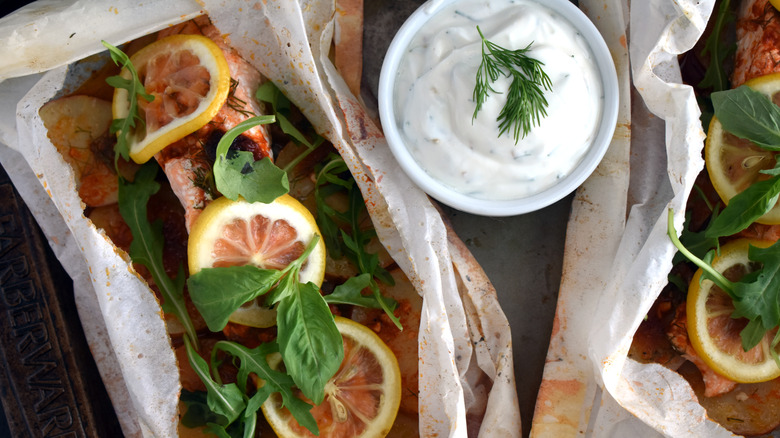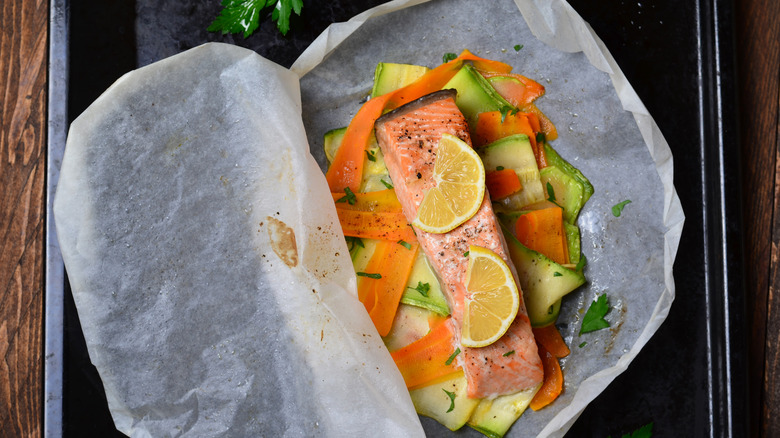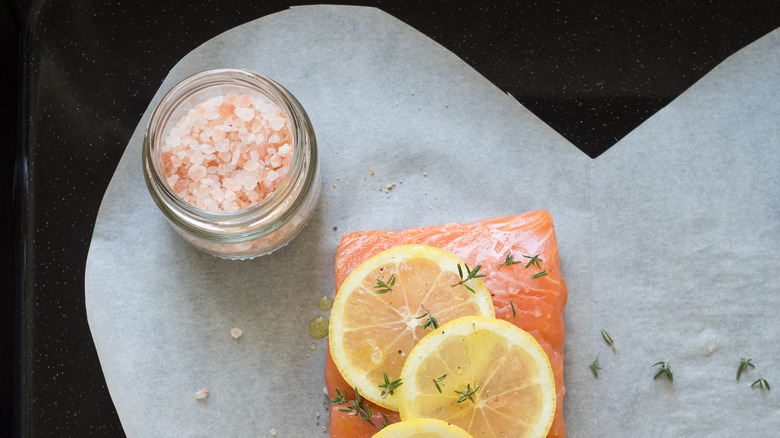What Does It Mean To Cook Food En Papillote
When it comes to all things culinary, the French tend to reign supreme. Revered and often considered the rule book when it comes to cooking technique, French cuisine is considered prestigious, formal, and never lacking in flavor.
The French are responsible for many classic dishes and techniques, as well as the hierarchy of a professional kitchen and the efficient assembly-line approach seen across the board in any back of house, per Le Foodist. But sometimes, the fanciest sounding and hardest to pronounce French cooking terms end up being the simplest ones. Mise en place, tarte tatin, au poivre, and chiffonnade come to mind. En papillote can be added to that list — and possibly close to the top. Despite its tongue-twister name, elaborate presentation, and seemingly intricate process, cooking food en papillote is far from intimidating. It's a pretty easy method and comes with a few advantages over other food preparations. It's also sure to impress all the guests at your next dinner party.
What does en papillote mean?
Cooking food en papillote simply means it is placed inside a package — usually parchment paper — and baked in the oven. The heat is trapped within the package and steams the food.
Per Collins English Dictionary, the French word for butterfly is "papillon." "En papillote," as a cooking term, is defined by Oxford Reference as "food ... cooked and served in a sealed package of greaseproof paper or aluminum foil. The method is used particularly for fish." The butterfly derivation of the word papillote applied to the cooking technique may lie in the shape the paper takes on to form the package — more specifically, it resembles two wings enveloping the food in the center.
The method of steaming food in a packet is not unique to the French. Tamales, pasteles, and collard green wraps all follow this method of capturing the heat to cook the food while allowing the flavors to meld and juices to be retained. A baked potato's skin does this in and of itself.
How to make en papillote
In order to make parchment paper or foil into a packet to hold ingredients, think of that butterfly. One of the easiest ways to tackle this transformation, as Bon Appétit llustrates, is to cut the sheet into the shape of a large heart using kitchen shears. You'll place the food in the center — where the monarch's body would lie. Bring one half of the heart over the food to meet the other side of the heart, and fold the edges over one another to create a tight seal. Now, pop the packet into the oven on a rimmed sheet pan to catch any juices that may escape your seal. Once it's done, open the edges carefully, as all of that contained hot steam will release at once.
En papillote is best for leaner, lighter proteins on the thinner side, such as salmon or chicken breast. Aromatics like fresh herbs, garlic, and lemon will impart added flavor and depth. If adding veggies, keep them thinly sliced for a shorter cooking time that matches the protein, per The Washington Post. You'll want to layer the ingredients and think more of building up the height as opposed to filling out the width, so everything will fit inside the butterfly's wings.
Why cook food en papillote?
There are a couple of advantages to cooking food en papillote as opposed to in a pot or pan. First, since the food is steamed, less fat is needed. There's no need to thoroughly grease a pan, nor will you be submerging the food in hot oil or fat. As the food steams in its own juices, all that delicious flavor and moisture is retained in the final product. Any aromatics, seasonings, or sauces you add to the packet will infuse throughout the food and remain trapped in the paper encasement.
And perhaps the biggest advantage for today's modern cook, en papillote is the equivalent of a one-pan meal — there is minimal cleanup needed. Not only will you avoid being elbows-deep scrubbing the crust off of a pan, but you can also enjoy your meal straight out of the parchment packet. Healthy, no clean-up, and a beautiful, flavorful presentation make en papillote a simple French technique worth giving a shot.



